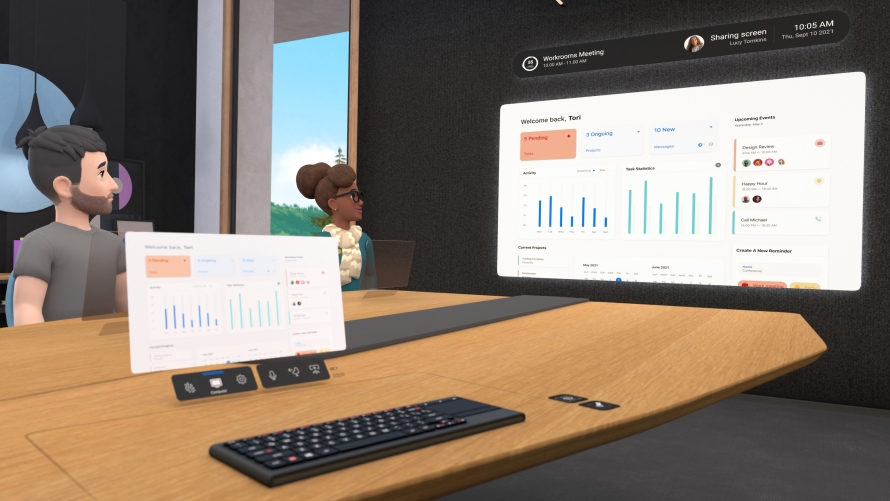The metaverse was always intended to be more than just a virtual reality application. Amid all the uncertainty about virtual reality, one thing’s for certain: the metaverse in here to stay, and it has implications for the future of work and the world of work at large. Can we work in the metaverse? Do people actually want to work in the metaverse?
The global pandemic, now entering its third year, has forced most of us to shift the way we think about connectivity, experience, and collaboration—or at least the way we do these things. In some ways, this has been difficult: We have missed celebrating with our families, spending time with friends, working out with fitness buddies, and brainstorming face-to-face with colleagues.
In other ways, the pandemic has presented an opportunity for us to find new and in some cases improved ways to go about our lives: While FaceTime happy hours may not replace the real thing, many have found working from home rather than gathering in a physical office with team members has made way for better work/life balance, a quick improvement of digital skills and no cost to performance in the job.
Yet as the end of the pandemic begins to appear on the horizon, we face the choice of how much of the old ways we want to return to, and how much of the new ways we now value too much not to preserve. We find ourselves open to new ways to think about connecting with one another socially, professionally, in groups as audience members, or opponents in a game—which is exactly what Mark Zuckerberg asked us to envision when he announced in December that Facebook would be changing its name to Meta, and focusing its energies beyond applications to the broader ambition of the metaverse.
In a presentation video that lasts nearly two hours, Zuckerberg explains that “the feeling of presence” is the “defining quality” of the metaverse. It is a place in which we, existing as 3D avatars, through the powers of augmented reality (AR) and virtual reality (VR), can move about freely, interacting with others, experiencing real-life scenarios but in a virtual world that can be quite parallel to our own, actual world. We will not engage in this metaverse in a basic 2D capacity, but in a way that gives the feeling of actually being there.
It isn’t a game. It’s a new way to interact as a society. Whether this sounds like the stuff of sci-fi dreams or nightmares, the metaverse is upon us, and it’s unlikely we can just opt out. It’s coming, but what exactly is it?
The metaverse is coming—but what is it?

The clearest way to begin thinking about the metaverse is to think about what it is not. It is not a new technology, app, or tool. The metaverse is a way of thinking about and combining many technologies to experience how we use tech and interact with it across our lives in an entirely new way. If this sounds vague, you’re not alone. Some have compared defining the metaverse today to discussing the Internet in the 1970s: the technology brings the ability, but we must creatively determine its applicability.
What will the metaverse cover?
According to the visionaries of such Big Tech agencies as Facebook/Meta and Microsoft, the metaverse will cover key aspects of our livelihoods and experiences, including:
Social relationships
While apps like Facebook, WhatsApp, Microsoft Teams and Zoom can offer us some level of socializing with others, the metaverse will take this a step beyond, enhancing the experience of feeling like you are actually with others, in a shared virtual space. You will feel present together in real time rather than just see one another onscreen as with existing apps.
Entertainment
COVID-19 lockdowns and travel restrictions have certainly taken a toll on how we are accustomed to being entertained. Live music, sporting events, gallery openings, and other forms of entertainment and culture. More than livestreaming, the metaverse aims to enable participants a more authentic experience, attending events and mixing with others, even buying fan items at metaverse concerts.
Gaming
This is an area that is perhaps the most easily comparable when it comes to thinking about what the metaverse experience can be. In Zuckerberg’s vision from his presentation video, he is experiencing the thrill of riding a surfboard alongside pro-surfer Kai Lenny. Games such as Fortnite have already moved past simply game play to create virtual worlds where people hang out together and, in the case of Fortnite, attend big-name concerts, including Ariana Grande and Travis Scott events. Tim Sweeney, CEO of Epic Games, maker of Fortnite, is so enthusiastic about the metaverse his entire company has been renamed Meta Platforms, Inc.
Fitness
Another area of our lives that the pandemic impeded on was fitness. Whether you are a frequent visitor to your local gym, a passionate member of your badminton club, or someone who enjoys daring cliff climbs in your spare time to keep mentally and physically in shape, the pandemic meant discovering new ways to keep fit. The metaverse is here for that, as well. While nothing can replace actual outdoor sport, competitive or otherwise, the metaverse will expand the possibilities of virtual workout experiences, from private personal trainers to group fitness classes.

Work
The world of work is possibly where the metaverse will have the greatest impact to all of use. Building on trends of remote work stemming from the pandemic, providing the in-person contact and the spontaneity it affords with the freedom to work from wherever, whenever could be truly revolutionising for companies and employees. Bill Gates predicts change is coming faster than you might think.
“Within the next two or three years,” Gates writes on his blog, “I predict most virtual meetings will move from 2D camera image grids […] to the metaverse, a 3D space with digital avatars.”
This will require VR goggles and motion capture gloves, all tools we can expect companies like Microsoft to roll out and ourselves to own in the future.
Education
This is another major area of our lives that will feel the impact (hopefully beneficial ones) of the metaverse. The pandemic forced the closure of physical schools in many parts of the world, but unlike the office, students are not expected to adopt full-time virtual school in the future. However, according to Gates, the pandemic did speed up the development of online curricula for many learning institutions and, because virtual learning requires access to quality technology outside of school, has served to narrow the tech gap in people’s homes. These are trends that should continue, and we can expect the metaverse to improve the ways we learn.
Commerce
Online shopping has grown exponentially during the pandemic, and studies show that younger and older generations alike are increasingly shopping online and preferring the experience. The metaverse can help rid online shopping of its negative points, including high returns of ill-fitting clothing or misrepresented products, because it will be possible to do things such as try on virtual outfits and try out virtual appliances, for example. In the metaverse, “shoppers” will have the experience of holding objects and assessing them from all angles before purchasing.
The advantages to working in the metaverse
The metaverse and all its potential is sure to dovetail with everything we do in life, because that is at the root of its purpose: to co-exist with our actual reality, to exist in tandem with our flesh and blood selves in our brick-and-mortar worlds. This creates exciting opportunities for breaking down the walls of time zones and geographic locations when it comes to work.
On a very practical level, the metaverse can transform how we work, where, with whom, and in what capacity. Immersive workspaces will make it possible to create mutual spaces where we can gather from wherever we happen to be. It will change the game in terms of broadening the range of potential candidates for jobs or projects, while closing the interpersonal and practical gaps created by working remotely. Here are some key ways the metaverse can change for the better the ways in which we work:
Diminishing the negatives of remote work
Until now, technology has served mainly to keep communication and interaction at work functioning despite physical distance rather than actually replicating the experience of being present with team members in person. Virtual work currently comes at the cost of easy reading of body language, the spontaneous sharing of ideas as you pass a colleague in the hall. All of this brings challenges to managers who feel disconnected from where the work is happening and can lead to disengagement. In the metaverse, we can join our team members in virtual workspaces as 3D avatars, in a way that far more closely feels like the real world.
Accenture works as a great example of a current metaverse, according to Microsoft’s Satdya Nadella. In her interview with the publication, she describes Accenture’s long-time metaverse, Altspace.
“Accenture is a great example of it,” Nadella . “Accenture is basically building what they describe as the Nth floor in Altspace where literally anybody across Accenture globally can any time drop in on the Nth floor and meet other Accenture employees.”
Visualise and solve problems in 3D
Many of us tackle problems visually. In fields such as healthcare, architecture, construction—to name but a few—being able to engage with ideas and problem solve visually, using 3D models, is a smarter way to work. In the metaverse, anything can be 3D-modeled, allow more precise assessment, design, and decision making with fewer time constraints and financial costs.
Imagine it like this: you’re working on a construction team, and a virtual electrician can join from his home (no matter where that may be) to help fix a wiring issue virtually.
No dependence on hardware and no restrictions of space
Space is not an issue in the metaverse. Virtual workspaces can be expanded easily. And there’s less need for hardware. Working in the metaverse will require only digital whiteboards and digital workstations, and 3D avatars are free and able to meet “face to face” without the need of conferencing equipment.
Technology has advanced faster than most realize, and it’s going to play a big role in the metaverse. For example, the use of augmented and artificial intelligence in meeting rooms. When you join the meeting, for example, you’d be able to see all the profiles involved, your past interactions with them, and information about everyone joining the call.
“We have now, when you go to a Team’s room, it will even segment everybody in a conference room into their own square, put them back in a meeting as if they were joining remotely,” Microsoft’s Satdya Nadella said. “That way then the remote participant can find people who are even sitting in a conference room, identify them, get their profile, and what have you. So that’s a great example of what is physical has become digitized. And you have people still meeting in a physical space and people who are remote but it’s all bridged.”
In addition, real-time translation will play a big role in the metaverse; it’ll allow people to connect like never before.
“So for example, a meetings artifact I talked about, just imagine, if there was a meeting in France, it was in French, where people were talking,” Nadella told Harvard Business Review.
How are companies preparing for the metaverse?
So, what can we expect to happen next in the arrival of the metaverse? If it seems to be moving awfully fast, it is—Mark Zukerberg has announced his plans to turn his own company into a metaverse enterprise within five years, and companies such as Nvidia, Sony, and Microsoft appear posed to hit similar goals.
The metaverse is positioned as the future universe to bet on. According to one report, the economic prospects of the metaverse are expected to reach 800 billion by 2025, and 2.5 trillion by 2030. Although Zuckerberg is the name most associated with the it, his company is not alone in investing in technology that will be key to making the metaverse a “reality.”
So far, there is Microsoft’s HoloLens, PlayStation’s VR helmets, Facebook’s Oculus, Epic Games’ video games, Alibaba’s Ali Metaverse, a new video game studio based on Tencet’s metaverse, and the owner of TikTok has shown interest. , and founder Philip Rosedale is rejoining the project.
As well as psychological buy-in from the general masses, this innovation in technology development will be key to making the metaverse accessible and practical. Today’s VR helmets are bulky and nausea-inducing to some users, and other tools will take a while for everyone to adopt across the board. As Bill Gates writes on his blog, “the acceleration of innovation in just starting.”
He writes of our needing, for example, “motion capture gloves to accurately capture your expressions, body language, and the quality of your voice,” to function in the metaverse, which is beyond what many of us currently have in our home offices.
“I think that this entire idea of metaverse is fundamentally this: increasingly, as we embed computing in the real world, you can even embed the real world in computing. That’s kind of how I think about it. Both because in some sense, one of the metaphors that I always use which is helpful is that as both an outside-in and inside-out,” Nadella said. “For example, you can have a space in which there are lots of cameras and microphones. And you can digitize the space. You don’t need to wear anything on your head.”
For the rest of us, the metaverse will require us to adapt to new ways of working and interacting, which we have shown to be adept in doing. Advancements in technology are difficult to opt out of without falling behind, and resistance to the metaverse may leave us locked out of a thriving, rich, virtual world.
If it delivers what’s promised, we will be able to have both a real world more on our own terms as far as location and work/life balance, and an interactive, dynamic world of work in which we collaborate and create in virtual spaces with more true-to-life connections than we’ve experienced through technology before.



